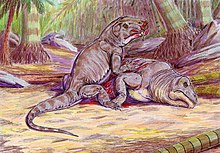Dinocephalia
| Dinocephalia | |
|---|---|

| |
| Restoration of two ). | |
| Scientific classification | |
| Domain: | Eukaryota |
| Kingdom: | Animalia |
| Phylum: | Chordata |
| Clade: | Synapsida |
| Clade: | Therapsida
|
| Suborder: | †Dinocephalia Seeley, 1894 |
| Subgroups | |
|
See Taxonomy | |
Dinocephalians (terrible heads) are a
Description


Apart from the
They include
Dinocephalians were among the largest animals of the
Size
Dinocephalians were generally large. The biggest herbivores (Tapinocephalus) and omnivores (Titanosuchus) may have massed up to 2 tonnes (4,400 lb), and were some 4.5 metres (15 ft) long, while the largest carnivores (such as Titanophoneus and Anteosaurus) were at least as long, with heavy skulls 80 centimetres (31 in) long, and overall masses of around a half-tonne.
Skull
All dinocephalians are distinguished by the interlocking incisor (front) teeth. Correlated features are the distinctly downturned facial region, a deep temporal region, and forwardly rotated suspensorium. Shearing contact between the upper and lower teeth (allowing food to be more easily sliced into small bits for digestion) is achieved through keeping a fixed quadrate and a hinge-like movement at the jaw articulation. The lower teeth are inclined forward, and occlusion is achieved by the interlocking of the incisors. The later dinocephalians improved on this system by developing heels on the lingual sides of the incisor teeth that met against one another to form a crushing surface when the jaws were shut.
Most dinocephalians also developed pachyostosis of the bones in the skull, which seems to have been an adaptation for intra-specific behaviour (head-butting), perhaps for territory or a mate. In some types, such as Estemmenosuchus and Styracocephalus, there are also horn-like structures, which evolved independently in each case.
Evolutionary history
| ||||||||||||||||||||||||
Phylogeny of Dinocephalia following Fraser-King et al. 2019[8]
|
The dinocephalians are an ancient group and their ancestry is not clear. It is assumed that they must have evolved during the earlier part of the
During the Wordian and early Capitanian, advanced dinocephalians radiated into a large number of herbivorous forms, representing a diverse megafauna. This is well known from the Tapinocephalus Assemblage Zone of the Southern African Karoo.
At the height of their diversity (middle or late
.Taxonomy


- Class Synapsida
- Order Therapsida
- Suborder Dinocephalia
- ?Driveria
- ?Mastersonia
- Family Estemmenosuchidae
- ?Family Phreatosuchidae
- ?Family Phthinosuchidae
- Family Rhopalodontidae
- Clade Anteosauria
- Family Anteosauridae
- Family Brithopodidae
- Family Deuterosauridae
- Clade Tapinocephalia
- ?Dimacrodon
- ?Driveria
- ?Mastersonia
- Family Styracocephalidae
- Family Tapinocephalidae
- Family Titanosuchidae
- Suborder Dinocephalia
- Order
See also
References
- ^ Day, Michael O.; Guven, Saniye; Abdala, Fernando; Jirah, Sifelani; Rubidge, Bruce; Almond, John (2015). "Youngest dinocephalian fossils extend the Tapinocephalus Zone, Karoo Basin, South Africa". South African Journal of Science. 111: 1–5.
- ^ "Driveria". Fossilworks.
- .
- .
- .
- S2CID 131447562.
- doi:10.1002/spp2.1411.)
{{cite journal}}: CS1 maint: multiple names: authors list (link - ^ Fraser-King, Simon W.; Benoit, Julien; Day, Michael O.; Rubidge, Bruce S. (2019). "Cranial morphology and phylogenetic relationship of the enigmatic dinocephalian Styracocephalus platyrhynchus from the Karoo Supergroup, South Africa". Palaeontologia Africana. 54: 14–29.
Further reading
- Carroll, R.L. (1988). Vertebrate Paleontology and Evolution. W.H. Freeman.
External links
- "Dinocephalia". Palaeos.com.
- "Dinocephalia". Palaeocritti.com.




